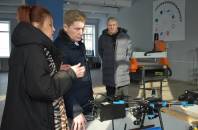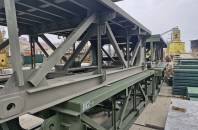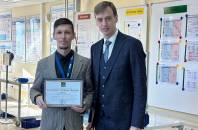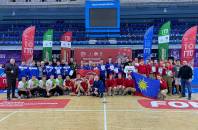|
Региональный журнал для деловых кругов Дальнего Востока
|
|
||||||||||||||||||||||
|
Вторник| 18 Ноября, 18:07 |
|
|
Тема номера
|
|||||||||||||||||||||

 Олег Кожемяко осуществил новогодние желания маленьких приморцев
В преддверии новогодних праздников заветные желания маленьких приморцев начинают сбываться. Так, Губернатор Приморского края Олег Кожемяко передал подарки от Деда Мороза двум маленьким приморцам: шестилетнему Мирону Глушаку из Тернейского муниципального округа и четырёхлетней Ольге Алимпиевой из Арсеньева.
Олег Кожемяко осуществил новогодние желания маленьких приморцев
В преддверии новогодних праздников заветные желания маленьких приморцев начинают сбываться. Так, Губернатор Приморского края Олег Кожемяко передал подарки от Деда Мороза двум маленьким приморцам: шестилетнему Мирону Глушаку из Тернейского муниципального округа и четырёхлетней Ольге Алимпиевой из Арсеньева.
 Родители ребят с ОВЗ обсудили вопросы образования и трудоустройства с представителями власти Приморья
Третья встреча клуба "На равных", призванного помогать гражданам решить непростые жизненные ситуации, состоялась в Приморье. В этот день участниками клуба стали родители детей с инвалидностью и ограниченными возможностями здоровья. Они обсудили с представителями власти вопросы образования и трудоустройства таких ребят.
Родители ребят с ОВЗ обсудили вопросы образования и трудоустройства с представителями власти Приморья
Третья встреча клуба "На равных", призванного помогать гражданам решить непростые жизненные ситуации, состоялась в Приморье. В этот день участниками клуба стали родители детей с инвалидностью и ограниченными возможностями здоровья. Они обсудили с представителями власти вопросы образования и трудоустройства таких ребят.
 Социальные предприниматели Приморья могут найти кадры и получить рекламу на радио при господдержке
Открыт прием заявок на две актуальные для социальных предпринимателей меры поддержки: "Размещение двух вакансий на HeadHunter" и "Размещение рекламы на радиостанции". Такой формат господдержки поможет социальному бизнесу Приморья продвигать свои услуги в осенний период и найти профессиональные кадры для расширения штата.
Социальные предприниматели Приморья могут найти кадры и получить рекламу на радио при господдержке
Открыт прием заявок на две актуальные для социальных предпринимателей меры поддержки: "Размещение двух вакансий на HeadHunter" и "Размещение рекламы на радиостанции". Такой формат господдержки поможет социальному бизнесу Приморья продвигать свои услуги в осенний период и найти профессиональные кадры для расширения штата.
 24 протокола составили на нарушителей противопожарного режима в приморских лесах
Лесничие и инспекторы в Приморье составили 24 протокола в отношении нарушителей особого противопожарного режима на землях лесного фонда. ОПР действует в большинстве муниципалитетов и подразумевает крупные штрафы за пренебрежение правилами пожарной безопасности.
24 протокола составили на нарушителей противопожарного режима в приморских лесах
Лесничие и инспекторы в Приморье составили 24 протокола в отношении нарушителей особого противопожарного режима на землях лесного фонда. ОПР действует в большинстве муниципалитетов и подразумевает крупные штрафы за пренебрежение правилами пожарной безопасности.
Chukotka Autonomous Region - the land of discoveries
Air traffic provides the only transport link to the region for many months of the year, connecting the rest of the country to remote Anadyr. However, even in the harsh Arctic climate of the Far North, investors are in for some nice surprises that have to do with the efficiency of mineral resource mining and implementation of infrastructure projects.
Chukotka holds a large amount of mineral resources and powerful sources of energy, which form a solid basis for creating and growing resource extraction and processing businesses in the region. The region holds large reserves of precious metals, already under development by Russian and international companies, notably Kinross Gold, Polymetal and Polyus Gold. The Chukotka regional government is aiming to attract additional investments to the region, including direct investment in commercial development of promising gold-mining opportunities.
The region awaits investment in geological exploration, heat generation, transportation, and coal mining. The Chukotka Region has large reserves of high-quality coal, which may command significant demand from Pacific Rim countries. The region has plans to shift the focus of local agriculture and food production from subsistence agriculture for local residents to deeper processing of meat and seafood, which can be offered to markets outside the Chukotka Region.
Roads as the cornerstone of regional development
However, the region’s resource potential is still untapped because mineral deposits have no transportation access. This brings large infrastructure projects to the forefront of Chukotka’s economic development, including construction and upgrades for regional automobile roads to access prospective precious metals mines and building utilities infrastructure.
Experts believe that before raising investment for private-sector business projects, the region needs to create essential infrastructure at a cost of RUB 134 billion, with around 80% of the total to be spent on road construction. However, government funding would make it possible to attract as much as RUB 150 billion in private investment to Chukotka through 2020. This forecast is based on the interest prospective investors have expressed in exploration and mining projects in the region.
Some infrastructure projects have already received financing under government funding programs, primarily the Federal Targeted Funding Program to Support the Economic and Social Development of the Russian Far East and the Transbaikal Region. The approved amount of funding through 2013 is approximately RUB 20 billion. The time for other programs will come.
A decision was made in 2012 to build a 1,800 km highway Kolyma-Omolon-Anadyr with access to the highway connecting Yakutsk with Magadan. “The new road would give impetus to economic growth in the region by making it possible to start commercial development of large mineral deposits in Western Chukotka,” says Chukotka Region Governor Roman Kopin. The highway would be built close to the promising Peschanka deposit in Bilibino District, which holds large reserves of copper (28 million tons), gold (160 tons), silver and molybdenum.
The region awaits investment in geological exploration, heat generation, transportation, and coal mining. The Chukotka Region has large reserves of high-quality coal, which may command significant demand from Pacific Rim countries.
The promise of natural resources
A comparison of the economic parameters of developing commercially gold deposits in Chukotka and similar global deposits of comparable size and ore grade shows that they are analogous in many respects, including capital expenditure per unit of reserves and output, extraction costs and returns on investment. Rapid preparation of key mineral deposits in the region - Kupol and Maiskoye - for commercial development demonstrates the similarity. Investors have calculated expected returns on these projects and their efficiency.
Industry experts estimate the aggregate cost of development of the Maiskoye, Kupol and Valunistoye deposits at USD 285-USD 310 million, with projected rates of return at 11.1%-34.4%. This is a very attractive ROI for gold deposits in the harsh climate of Chukotka. The expected ROI of Russian gold deposits is generally 10%-15% or lower. Ten gold deposits in the Chukotka Region offer returns above 10%, with possible combined annual gold production up to 50 tons.
It should be noted that companies developing deposits of this kind are protected against gold price volatility. Commercial development of the portions of these deposits with mining facilities already in place, if exploration brings positive results, would make it possible to replace the depleted reserves of mined deposits after 2015 to keep the region’s operational mines and those under construction running well beyond then.
Power generation follows the resources
To start development of promising mineral resource areas, the government of Chukotka had to organize road building and creation of electricity generation and supply infrastructure. A floating nuclear power plant has been assembled in Arctic Ocean Pevek, using KLT 40C reactors, replacing an obsolete thermal power and heat generator. There are plans to upgrade the thermal Egvenkinot GRES to satisfy the demand for power in Chukotka’s isolated power grid.
All generators are independent from each other and supply their own grids, except for Chaun TEC and Bilibino Nuclear Plant, which are connected by a 110 gV line into the Chaun-Bilibino electric utilities hub. Construction of new 110 gV power lines connecting Komsomolskoye and Mayskoye, Bilibino and Kupol, Kupol and Peschanka, Anadyr and Beringovsky should completely meet the demand for power needed to develop gold deposits Mayskoye, Dvoinoye and Kupol, the major Peschanka copper, silver and gold deposit in Bilibino District, and the Bering coal fields.
Upgrading the 110 gV Bilibino-Komsomolsky-Pevek power line, as well as the Pevek grid, and laying a 35,000-volt backup cable across Anadyr River will ensure a more reliable power supply for consumers at the Chaun-Bilibino and Anadyr power hubs. New 110 gV power lines connencting the Valunistoye, Komsomolskoye and Ugolnye Kopi (coal fields) to Kanchalan and Valunistoye will connect all three utilities hubs in the region, enabling a cross-flow of electric power among them.
Made in the Far North
The region has plans to shift the focus of local agriculture and food production from subsistence agriculture for local residents to deeper processing of meat and seafood, which can be offered to markets outside the Chukotka Region.
Food and meat production in Chukotka is mainly reindeer meat. Steadily expanding demand for artisan and organic food in most developed countries makes exports of reindeer meat from Chukotka potentially attractive. The plan is to preserve the traditional lifestyle of Chukotka’s native people, with proper modifications to some work processes and a focus on waste-free production of reindeer herding products.
In addition to meat, fat and organs, leather and fur, reindeer are a source of materials for the pharmaceutical industry (unossified and ossified antlers, biologically active supplements, blood serum). Experts forecast that organization of industrial-scale slaughtering and development of reindeer processing infrastructure at regional ports would enable Chukotka to increase revenue from reindeer herding to USD 4.7 million by 2020.
As far as the fisheries and seafood production are concerned, the share of modern fish processing has increased significantly in Chukotka over the past five years. The fishing and fish-processing industry has become the leader among key sectors of the regional economy in terms of revenue, and continues to demonstrate strong growth rates and profitability.
***
From Far Eastern Capital files:
Chukotka’s power sector consists of government-controlled power plants: Bilibino Nuclear Plant, a division of state-owned Rosenergoatom and Chukotenergo generators, including Anadyr TEC (heat and power generator), Egvekinot GRES, Chaun TEC, and Northern Power Grid, as well as Anadyr Gas Motor TEC, leased and operated by Chukotenergo. The combined output of all major regional generators is 195.2 MWh of power and 444.3 GCal-hour of heat.
***
From Far Eastern Capital files:
Chukotka holds approximately 10% of all explored gold reserves in Russia. Gold reserves in Chukotka were estimated at 469.7 tons as of January 1, 2011.
Less than 3% of prospective oil resources in Chukotka have been explored, but promising oil and gas areas have been identified in the region and on the continental shelf around it. Forecast resources of O&G areas on the shelf are estimated at 10 billion tons of oil equivalent.
 #ПозывнойКультура: Дед Мороз поздравил участников СВО в госпитале ТОФ с наступающим Новым годом
В преддверии Нового года агитбригада #ПозывнойКультура побывала в госпитале Тихоокеанского флота в субботу, 28 декабря. Для участников СВО, находящихся на лечении и реабилитации, прозвучали музыкальные поздравления. Со словами самых теплых пожеланий подарки военнослужащим вручила заместитель Председателя Правительства Приморского края – министр культуры и архивного дела Елена Бронникова.
#ПозывнойКультура: Дед Мороз поздравил участников СВО в госпитале ТОФ с наступающим Новым годом
В преддверии Нового года агитбригада #ПозывнойКультура побывала в госпитале Тихоокеанского флота в субботу, 28 декабря. Для участников СВО, находящихся на лечении и реабилитации, прозвучали музыкальные поздравления. Со словами самых теплых пожеланий подарки военнослужащим вручила заместитель Председателя Правительства Приморского края – министр культуры и архивного дела Елена Бронникова.
 Губернатор Приморья оценил оснащение Индустриального колледжа в Арсеньеве
Очередной день работы Губернатора Приморского края Олега Кожемяко в муниципалитетах региона начался с посещения Приморского индустриального колледжа в Арсеньеве. Глава региона изучил новое оборудование, на котором готовят специалистов технических специальностей.
Губернатор Приморья оценил оснащение Индустриального колледжа в Арсеньеве
Очередной день работы Губернатора Приморского края Олега Кожемяко в муниципалитетах региона начался с посещения Приморского индустриального колледжа в Арсеньеве. Глава региона изучил новое оборудование, на котором готовят специалистов технических специальностей.
 Комплекты быстровозводимых мостов начали поставлять в Приморье
Началась поставка средних автодорожных разборных мостов (САРМ) для проведения аварийно-восстановительных работ на дорогах Приморья. Всего на следующий год закуплено 11 комплектов. При необходимости комплекты САРМ будут использованы для оперативного восстановления проездов во время паводков.
Комплекты быстровозводимых мостов начали поставлять в Приморье
Началась поставка средних автодорожных разборных мостов (САРМ) для проведения аварийно-восстановительных работ на дорогах Приморья. Всего на следующий год закуплено 11 комплектов. При необходимости комплекты САРМ будут использованы для оперативного восстановления проездов во время паводков.
 Почти 900 сотрудников предприятий Приморья уже владеют бережливыми технологиями благодаря нацпроекту "Производительность труда"
Итоги реализации национального проекта "Производительность труда" и планы на будущее озвучил министр экономического развития Приморья Андрей Блохин на награждении команды Регионального центра компетенций. За четыре года работы нацпроекта реализовано 78 проектов по внедрению бережливых технологий на предприятиях края.
Почти 900 сотрудников предприятий Приморья уже владеют бережливыми технологиями благодаря нацпроекту "Производительность труда"
Итоги реализации национального проекта "Производительность труда" и планы на будущее озвучил министр экономического развития Приморья Андрей Блохин на награждении команды Регионального центра компетенций. За четыре года работы нацпроекта реализовано 78 проектов по внедрению бережливых технологий на предприятиях края.


